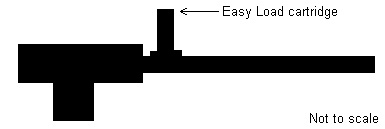| Home > Spudguns > Modifications and Improvements |
| Home > Spudguns > Modifications and Improvements |
The basic spudgun is great, but has some significant limitations. This page presents some solutions to these problems with a few simple modifications. The list is rather small right now, but it should grow with time. If you wish to contribute, then just email me with your ideas.
Take a look at the picture below to see the high voltage mod installed on my spudgun. The large silver box is the battery pack, while the black box contains the HV power supply.


If you look closely at the refilling tip, you will notice that there is a plastic lip about a centimeter and a half from the business end of the tip, this lip is what is very important. Do not damage it while converting for Starch Abuser ( I like that by the way ).
Now, you need something that will fit over the tip, but will still catch on the lip, so that when you press down on the something, butane gas is let out in a controlled fashion. More or less.
What I have used are your everyday coins that have a hole drilled in the center of them. I would recommend a size, but the o.d. of the tip varies from manufacturer to manufacturer.
Once you have your " actuator " attached, all you need to do is to channel the resulting butane gas into the combustion chamber. I have set mine up so that a rubber hose ( whose i.d. varies according to the tip) just fits over the top part of the tip on the canister. It will need to fit tight, you would not want it to fly off and waste your propellant. Use epoxy if necessary.
The other end of the rubber hose is attached to metal tubing, or straight to the control valve. This is important, since the lack of a flow control/ shutoff valve will allow combustion temperatures and pressures to be applied to the rubber hose, and also to the butane canister. Do not leave out the valve!! Reason for the metal tubing from the valve to combustion chamber? To prevent blow out of rubber hose form combustion temperatures in middle of potato fight.
The metal tubing from the combustion chamber needs to be terminated at both ends with compression fittings. This is simple. One fitting, will attach the tubing to the valve, while the other needs to be securely fastened to the combustion chamber in one way or another. I used a compression fitting that had the female side attached to the combustion chamber via way of a large ball of epoxy. It works.
Now to use the autorefiller, just load barrel, turn on gas ( press coin or whatever ), open valve, let chamber fill, and shutoff valve, and then gas. Now you are ready to go. Hit the ignitor, and away she goes
Combustion Chamber Changes...
Having been into auto racing since I was quite young, I have been applying some of the things I have learned to spudding. Everyone who has been around high performance cars know the Mopars Hemi (short for hemispherical head) engine was one of the most powerful production engines of that era. This power was contributed significantly by the design of the combustion chamber. I'm willing to bet the most spud guns are only getting 50 to 60 percent combustion in the designs I have seen.
Just because it goes off doesn't mean it burn all available fuel. So I though went into the books to find out what Dodge had done in it's Hemi to combat this problem. I found that by rounding the back of the combustion chamber and placing the ignition device dead center in the back of the chamber, it ignites a flame front equally in all directions and provides a better surface and more surface area to reflect the pressure wave and flame front forward into the front of the chamber and into the barrel. The flame front will continue down the barrel providing spud acceleration until the potato actually leaves the barrel. While this happens on many spud guns (evident by a flame emerging from the barrel instead of just smoke), the rounded chamber end tends to push the unburnt fuel and air into the barrel instead of slow burning under oxidized fuel from a poor combustion. This further adds to the pressure wave. I haven't measured to PSI differences but using as close to the same charges as I can, I notice bigger brighter flames coming from the barrels end than the standard combustion chamber on a gun that is otherwise the same. I haven't yet measured spud distance but I can tell a definite increase in the height when shot at the a thirty degree angle to the ground that I use as a testing standard.
Ignition Inquiries...
As with cars, a good ignition of the fuel/air mixture is required for good spud projection. Using BBQ grill ignitors and lantern ignitors might work but they don't work well. They use a pezio electric disk which produces a quick, snappy, cold spark. This doesn't ignite the mixture well and much is just blown out into the atmosphere. It doesn't take a great deal of pressure to get a spud moving down the barrel. So you want as much pressure as you can build as quickly as possible. The problem lies in the fact that the amount of pressure you can build is inversely proportional to the amount of time you have to build it. The more pressure you build, the faster the spud moves out of the barrel. The fast the spud exits the barrel, the less time you have to build pressure. You your fuel/air mixture to ignite as fast and completely as physics will allow. So among other things, you need the best ignition system you can get. The auto industry has spent millions of dollars researching the best way to ignite an fuel/air charge. I use am currently using an DIS (Direct Ignition System) off an Oldsmobile to fire my gun. The DIS coils produce nearly 100,000 volts at close to an amp when fired with a pulse capacitor. This produces a hot, fat, long lasting spark. The grill and lantern ignitors produce an output of maybe 1,000 or 1,500 volts in the micro amp range (.0001). You can see the difference. Grill and lantern ignitor are designed to be small and easy to fit on a lantern or in a grill. They are designed to just ignite the fuel/air mixture, not produce a rapid powerful combustion. They draw back to using a DIS system is that they are large and heavy. You couldn't use one on a hand gun. But they are great for a tripod mounted system. They most important draw back I must mention here is that they are deadly and will kill you without a second chance. I have heard of mechanics losing fingers to these devices (These are the lucky ones that got hit by just a spark that jumped to one of their extremities. Direct contact with one of the high current wires causes your life flash to before your eyes.). There are safer alternatives which still provide a satisfactory ignition system. You can use are regular points type ignition coil with a buzzer from Radio Shack instead of the DIS coils and capacitors.
Fuel Facts...
I have much talked about the relationship between spud gun and auto engines. Fuels are no different with one exception; octane ratings. The lower an octane rating a fuel the quicker it combusts. While I have been talking about rapid combustion, there is a draw back to low octane fuels. Burning fuels create hot expanding gases that push the beloved spud out of the barrel. A low octane fuel combusts very quickly and does not produce as much heat and therefore less pressure. For the same reason 93 octane gas produces more horsepower in your car, it sends your spuds farther down range. The exception I mentioned before is that in an auto engine, too high an octane will destroy it. There are thousands of detonations a minute at idle in a car. High octane fuel produces more heat than a lesser octane so you can burn up your engine with high octane. Also, at high RPMs extremely high octane fuel will continue to burn when the piston is returning to the top of the cylinder. This is why you see fire coming from the pipes of top fuel dragsters. A side note I must include is that, by these standards, 93 octane pump gas is not really a high octane. Since the spud does not return down the barrel, we don't have to worry about it. Also since even the fastest spud loaders only fire once every minute or so, heat is not as big of concern. You should make sure you gun is not over heating though. Nitromethane is about the most potent fuel you can get short of actually using gun powder. Even more powerful if you get the fuel/air mixture right. I used nitromethane and NO2 (nitrous oxide) in my latest experimental shots. I don't know what happened to the spud but it blew the spark plug and a section of the end cap out of the back.


